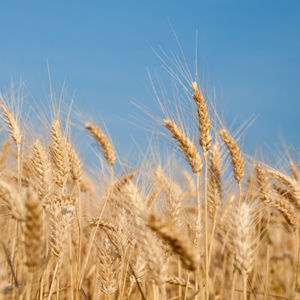
Lectins are sugar-binding proteins. In plants, lectins serve as a natural defense system to fight off mold and parasites.
One of the reasons grains may be such a problem to eat is because they contain lectins - in addition to gluten. Although gluten in wheat, rye and barley has gotten the headlines, lectins are a bigger problem, according to Sayer Ji, author of
The Dark Side of Wheat.Wheat found in bread today (triticum aestivum) is a far cry from the bread of Roman times. It has been genetically tweaked - not genetically modified, but aggressively crossbred and hybridized. And with all that hybridization, the gluten content of some varieties has increased by as much as 50 percent.
Wheat also contains a lectin known as wheat germ agglutinin (WGA). Lectins are sugar-binding proteins. In plants, lectins serve as a natural defense system to fight off mold and parasites. When plants sense an invader, lectins counterattack by binding to the foreign sugar molecules to stop the unwanted cells in their tracks. That is good news for the plants.
But when lectins get into your body, they are still programmed to attack sugar molecules. That is bad news for your digestive system, which is lined with sugar-containing cells that help you break down food. Lectins are drawn right to that lining, and your immune system retaliates.
Lectins are found in all foods, but in some more than others. All seeds of the grass family - wheat, rye, rice, spelt, etc. - are high in lectins. You also find lectins in beans, dairy and in the nightshades (tomatoes, potatoes, eggplant). According to a 1991 study, dairy may be potentially more harmful in pasteurized, processed milk because of the reduction of SIgA, an immunoglobulin that binds dangerous lectins.
Comment: Our research suggests that the best protection against lectins is to stop eating them. They are particularly resistant to stomach acid and digestive enzymes and research suggests that at least 60 percent remain biologically active and immunologically intact. This combination represents a time bomb in the digestive tract.
Our change in diet since the Agricultural Revolution, Industrial Revolution and the Modern Age has systemically destroyed our health. The mismatch between our ancient physiology - which thrived with little or no edible plant food - and our current diet is at the root of many so-called diseases of civilization: coronary heart disease, obesity, hypertension, type-2 diabetes, cancer, autoimmune disease, osteoporosis, etc.
We are children of the Ice Age. We have spent a significant amount of time in an Ice Age with only very brief periods of warmer weather which was when edible plant could have grown over a significant part of the Northern Hemisphere. Only those who adapted under such frigid and difficult conditions survived. It is certainly food for thought as the next
Ice Age approaches.
For more information, please visit our forum threads
Life Without Bread and
Ketogenic Diet: Path to Transformation?

Comment: Our research suggests that the best protection against lectins is to stop eating them. They are particularly resistant to stomach acid and digestive enzymes and research suggests that at least 60 percent remain biologically active and immunologically intact. This combination represents a time bomb in the digestive tract.
Our change in diet since the Agricultural Revolution, Industrial Revolution and the Modern Age has systemically destroyed our health. The mismatch between our ancient physiology - which thrived with little or no edible plant food - and our current diet is at the root of many so-called diseases of civilization: coronary heart disease, obesity, hypertension, type-2 diabetes, cancer, autoimmune disease, osteoporosis, etc.
We are children of the Ice Age. We have spent a significant amount of time in an Ice Age with only very brief periods of warmer weather which was when edible plant could have grown over a significant part of the Northern Hemisphere. Only those who adapted under such frigid and difficult conditions survived. It is certainly food for thought as the next Ice Age approaches.
For more information, please visit our forum threads Life Without Bread and Ketogenic Diet: Path to Transformation?